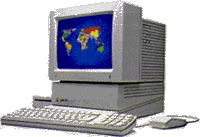History of computer design: Apple IIgs
4-frogdesign || 5-Corporate focus || Conclusion || Bibliography & links
![]()
![]()
 A year after
the Apple IIc was introduced,
frogdesign began work on the next - and last - major update
to the Apple II family. When it appeared in October 1986,
the Apple IIgs exemplified Gassée's plan to gain
profits via technological advance - it used a unique and
powerful mouse-driven operating system that was a hybrid
between that of the Apple II and the Macintosh. It was also
a hybrid in industrial design, signaling a shift in the
appearance of Apple's products towards the standard that had
been set by IBM.
A year after
the Apple IIc was introduced,
frogdesign began work on the next - and last - major update
to the Apple II family. When it appeared in October 1986,
the Apple IIgs exemplified Gassée's plan to gain
profits via technological advance - it used a unique and
powerful mouse-driven operating system that was a hybrid
between that of the Apple II and the Macintosh. It was also
a hybrid in industrial design, signaling a shift in the
appearance of Apple's products towards the standard that had
been set by IBM.
The Apple IIgs has both an external keyboard and an external display, but it does not entirely take the form of the PC. Instead, its case is visually separated into two components, with a triangular piece topped with a rectangular lid. The bottom triangle laps over by a couple of inches towards the user, making a visual reference to the keyboard wedge of the earlier Apple II. This wedge has a function; it protects the front of the machine's long circuit board which fills the bottom section. The components in the top box do not require the full length of the motherboard, so it is cut off, leaving the wedge. While the footprint on the desk is no smaller, this design greatly decreases the apparent size of the computer and retains its identity as an Apple II. Its platinum colour and the Snow White lines running on its sides and top give the product an elegance which further identifies it as a new Apple product.
Home || Introduction || Historiography || 1-Cottage industry || 2-Emerging standards || 3-Macintosh
4-frogdesign || 5-Corporate focus || Conclusion || Bibliography & links







.jpg)








